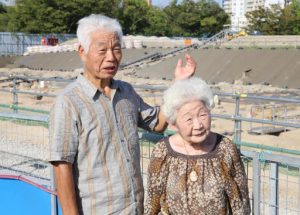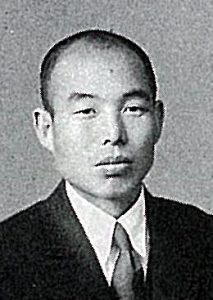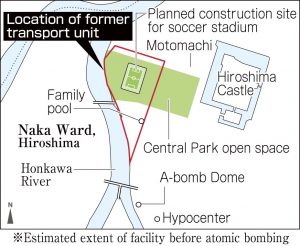Striving to fill voids in Hiroshima, evidence of victims remains 76 years after atomic bombing—At last chance for children to pray for father’s soul before unit’s remnants become soccer stadium, “Dad was here”
Aug. 7, 2021
by Kyosuke Mizukawa, Staff Writer
The single atomic bomb dropped by the U.S. military 76 years ago also incinerated a military facility of the former Japanese Army’s transport unit known as the Chugoku District transport soldier recruitment unit (“Shichotai” in Japanese). The facility was located in what is now Hiroshima’s Central Park, in the city’s Naka Ward. Tadashi Koyama, 76, a resident of Hiroshima’s Asakita Ward, lost his father, Satoru Koyama, then 37, who served in the Shichotai unit. At the time of the bombing, Tadashi was only three months old. The only way Tadashi was able to experience his father’s love was through postcards sent by him while he was alive. One asked, “Are you behaving well?” On August 6 this year, Tadashi prayed for the soul of his departed father, of whom he has no memory, at the Shichotai remnants, which were excavated this year.
“I was a mischievous boy, and I don’t know how many times my mom said, ‘But, your father was such a nice person.’ And the more I learn about him, the more I realize he was a good father,” said Tadashi, as he gazed out longingly over the barrack artifacts.
Satoru Koyama was a professor at Okayama Normal School (now Okayama University). He taught philosophy and Buddhism. In May 1945, shortly after Tadashi was born, Satoru was called up to serve in the Shichotai unit, leaving his wife and four children in Okayama City.
A postcard dated July 4, 1945, said, “It is becoming hotter. Michiko and Tadashi, are you behaving well?” Satoru sent postcards to his wife and children every few days, inquiring about whether there was enough food and whether breastfeeding was going well. After he learned that his wife and children had evacuated to the northern part of Okayama Prefecture for the sake of safety, his postcard dated August 1 described his reaction. “There should be many benefits in our children growing up in the quiet countryside. I’m very happy, too.” That was his last postcard.
On that fateful day, August 6, 1945, the military facility, located less than one kilometer from the hypocenter, was completely destroyed. Tadashi said, “A soldier from the same hometown as my father survived. He told us that, at the time, my father was stripped to the waist and doing exercises.” Satoru’s remains have never been found.
The mother and four children subsequently had to rely on her father for their livelihoods, but he died when Tadashi was 5. His mother died of ill health when he was 14. The four siblings began living in Hiroshima, where the oldest brother worked as a teacher.
Looking at the remnants of the Shichotai unit, Tadashi remembered what he had heard from one of his father’s students. Satoru apparently had said, “I don’t want to go,” at a farewell party held before he joined the Japanese Army. When Tadashi heard that, anger welled up in him. “Why did they so cruelly continue fighting the war?”
The Hiroshima City government will remove the remnants after mid-August prior to construction of the soccer stadium. Tadashi invited his sister Michiko Koyama, 80, a resident of Hiroshima’s Asakita Ward, to see the artifacts of the Shichotai unit, since this would be the last chance. “My only memory of my father was of him holding me in his arms on a moonlit night. Tadashi was a newborn so…,” Michiko said as she looked at her brother.
“I want to tell my dad, ‘I’ve lived for almost 80 years, and we’ll meet again soon.’” Making an effort to be cheerful, Tadashi added, “The atomic bomb destroyed the lives of many people in an instant. I hope more young people will come here and give a thought to the tragedy.”
(Originally published on August 7, 2021)
The single atomic bomb dropped by the U.S. military 76 years ago also incinerated a military facility of the former Japanese Army’s transport unit known as the Chugoku District transport soldier recruitment unit (“Shichotai” in Japanese). The facility was located in what is now Hiroshima’s Central Park, in the city’s Naka Ward. Tadashi Koyama, 76, a resident of Hiroshima’s Asakita Ward, lost his father, Satoru Koyama, then 37, who served in the Shichotai unit. At the time of the bombing, Tadashi was only three months old. The only way Tadashi was able to experience his father’s love was through postcards sent by him while he was alive. One asked, “Are you behaving well?” On August 6 this year, Tadashi prayed for the soul of his departed father, of whom he has no memory, at the Shichotai remnants, which were excavated this year.
“I was a mischievous boy, and I don’t know how many times my mom said, ‘But, your father was such a nice person.’ And the more I learn about him, the more I realize he was a good father,” said Tadashi, as he gazed out longingly over the barrack artifacts.
Satoru Koyama was a professor at Okayama Normal School (now Okayama University). He taught philosophy and Buddhism. In May 1945, shortly after Tadashi was born, Satoru was called up to serve in the Shichotai unit, leaving his wife and four children in Okayama City.
A postcard dated July 4, 1945, said, “It is becoming hotter. Michiko and Tadashi, are you behaving well?” Satoru sent postcards to his wife and children every few days, inquiring about whether there was enough food and whether breastfeeding was going well. After he learned that his wife and children had evacuated to the northern part of Okayama Prefecture for the sake of safety, his postcard dated August 1 described his reaction. “There should be many benefits in our children growing up in the quiet countryside. I’m very happy, too.” That was his last postcard.
On that fateful day, August 6, 1945, the military facility, located less than one kilometer from the hypocenter, was completely destroyed. Tadashi said, “A soldier from the same hometown as my father survived. He told us that, at the time, my father was stripped to the waist and doing exercises.” Satoru’s remains have never been found.
The mother and four children subsequently had to rely on her father for their livelihoods, but he died when Tadashi was 5. His mother died of ill health when he was 14. The four siblings began living in Hiroshima, where the oldest brother worked as a teacher.
Looking at the remnants of the Shichotai unit, Tadashi remembered what he had heard from one of his father’s students. Satoru apparently had said, “I don’t want to go,” at a farewell party held before he joined the Japanese Army. When Tadashi heard that, anger welled up in him. “Why did they so cruelly continue fighting the war?”
The Hiroshima City government will remove the remnants after mid-August prior to construction of the soccer stadium. Tadashi invited his sister Michiko Koyama, 80, a resident of Hiroshima’s Asakita Ward, to see the artifacts of the Shichotai unit, since this would be the last chance. “My only memory of my father was of him holding me in his arms on a moonlit night. Tadashi was a newborn so…,” Michiko said as she looked at her brother.
“I want to tell my dad, ‘I’ve lived for almost 80 years, and we’ll meet again soon.’” Making an effort to be cheerful, Tadashi added, “The atomic bomb destroyed the lives of many people in an instant. I hope more young people will come here and give a thought to the tragedy.”
(Originally published on August 7, 2021)










